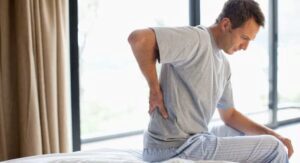Morning Back Pain
Disclosure: By clicking on the product links in this article, Mattress Nerd may receive a commission fee at no cost to you, the reader. Read full disclosure statement.
Mattress Nerd consulted Dr. Steven Knauf, D.C. to ensure that this article met our editorial standards
When you wake up first thing in the morning, do you immediately feel soreness in your back? If so, you’re not alone. Many people around the world deal with morning back pain, but very few understand what exactly causes it. A majority of the time, morning back pain can be traced back to a common cause: poor sleep hygiene.
We spend a third of our lives in bed, so naturally, our sleep personality can take a major toll on our physical well-being. If you’re tired of dealing with low back pain in the morning, we recommend you read this helpful guide that may help you get the good, pain-free night’s sleep you deserve.
Why Does Your Back Hurt in the Morning?
As mentioned earlier, morning back pain may be attributed directly to or in part by our sleep experience. However, there are numerous factors that go into sleep health, and it’s crucial that you pinpoint the exact causes of morning back pain and morning stiffness. Below are just a couple of ways your sleep experience can be causing or worsening your lower back pain or upper back pain in the morning.
Sleep Position and Back Pain
There are several different sleeping positions, and each one comes with its own set of benefits and downsides. Depending on your sleeping posture, you could be making your back pain worse.
Side Sleepers
When we sleep on our sides, our shoulders and hips can be too high or too low, leading to spinal misalignment. With our spines misaligned, our backs are forced into an uncomfortable and unnatural position for approximately 8 hours. This can mean that you wake up with not just back pain, but also hip pain and possible neck and shoulder pain as well.
For more information, as well as ways to combat back pain in side sleepers, see our guide on how to properly sleep on your side and our best mattresses for side sleepers.
Back Sleepers
While sleeping on your back, you have to ensure that your head, neck, shoulders, back, hips, and legs are all straight and aligned. Like with side sleepers, back sleepers can experience their own alignment issues by not properly supporting the natural curves of their spine which can lead to poor spinal health and potential back pain. Crossing your legs or laying with your hand over your head are common sleeping postures that could lead to discomfort in other joints or areas of the body as well.
That said, back sleeping is considered by many to be the healthiest sleeping position overall. If you sleep on your back and still experience morning back pain, your mattress might be to blame. To learn more, check out our best mattresses for back sleepers.
Stomach Sleepers
Stomach sleepers, like back sleepers, need adequate support for their head, neck, shoulders, and legs. They also need extra support for their hips, which can sink deep into the mattress and lead to spinal misalignment. Additionally, stomach sleepers often have to sleep with their head to one side for prolonged periods which may lead to joint and muscle issues.
Although all sleep positions can experience back pain, stomach sleepers may be most prone to this problem because of all the excess weight being placed on the center of their body and the stress applied to their neck.
Related: How to Properly Sleep on Your Stomach
Can Your Mattress Cause Morning Back Pain?
It’s not just your sleep position that can cause morning back pain. An old or new mattress can be a possible cause as well. The right mattress can be the difference between having a great, refreshing night’s sleep, and waking up with major back pain, so we recommend that you take the right steps to ensure you have the right bed option.
Below are the various types of mattresses and how they may contribute to your back pain.
Memory Foam
Memory foam is known to be soft and contouring, cradling your body and giving you a very personalized sleep experience. If you have a heavier body frame, then you may sink too much into the memory foam, thereby leading to spinal misalignment and poor back health. However, there are denser memory foam options out there for both heavy sleepers and stomach sleepers.
Latex
Latex mattresses are very soft and bouncy, making them great for lighter sleepers and side sleepers with back problems. If you’re a strict stomach sleeper or even a back sleeper, a latex mattress may not give you the right amount of support, and it can actually lead to back pain in the morning.
Innerspring
Innerspring mattresses are nice and firm, meaning that they can support stomach sleepers and most back sleepers and provide the right amount of back support. If you sleep on your side, it’s best to stay away from innerspring as they can push your shoulders and hips out of alignment with your spine, potentially resulting in back pain.
How to Avoid Morning Back Pain
While there isn’t a one-size-fits-all solution for morning back pain, there are ways to avoid or lessen it so that it doesn’t affect your overall quality of life. Below are a few treatment options and lifestyle suggestions you can try to alleviate back pain, and as always you should be encouraged to discuss any activities with a healthcare provider to make sure they are safe to perform depending on your condition.
Exercise
You don’t need to do excessive exercises to fight morning back pain. Gentle stomach crunches can help with loosening your back muscles and spine, but you shouldn’t press yourself too hard if the pain is too great. Another good morning exercise to combat back pain is to try swimming, even if it’s in short sessions. The water can support your body so that you aren’t putting too much strain on your back and neck.
Stretch
There are several stretches you can try for back pain in the morning. One popular stretch is the back flexion technique. While lying flat on the ground on your back, pull both of your knees to your chest while flexing your head forward. You should feel a comfortable stretch across your mid back and low back.
Another good stretch is the knee to chest method. While lying on your back with your knees bent and both heels on the floor, place both of your hands behind one of your knees and pull it up to the opposite side of your chest. This stretches your back and the gluteus and piriformis muscles in your buttocks.
Pain Medications
There are more and more studies suggesting that individuals obtain better relief for back pain through conservative treatment like chiropractic care, yoga, stretching, and exercises. However, for some this may not be enough and pain medications may be warranted.
You should always seek professional medical and healthcare advice when it comes to trying medication, but there are some over-the-counter solutions for battling less intense aches and pains.
Acetaminophen, ibuprofen, and Advil are great OTC painkiller options, but you do not want to rely on them every day. If you are taking OTCs every day or the pain persists, then it may be time to seek the help of a medical professional who can suggest alternative routes for care like a chiropractor.
Topical Solutions
There are also topical options for back pain relief that you can try if the other methods don’t work. Tiger Balm pain-relieving ointment, Traumaplant Comfrey Cream, and Dr. Blue Cool Gel are all alternative health treatments for back pain, but it’s advised that you carefully read the instructions and consult with your chiropractor, doctor, or physical therapist for professional medical advice before using them.
Conclusion
Morning back pain is a problem that plagues countless people each year. Hopefully, these methods will provide some pain relief so that you don’t need to deal with such discomfort in the future.
Meet Our Medical Reviewer
Dr. Steven Knauf, D.C.
Steven Knauf, D.C. is Executive Director of Chiropractic and Compliance at The Joint Chiropractic. Dr. Knauf began working at The Joint in 2011. After spending four years as a chiropractor in-clinic, he took the role of Senior Doctor of Chiropractic for 13 of The Joint Corp. clinics and, subsequently, was elevated to a director position at the corporate office.


